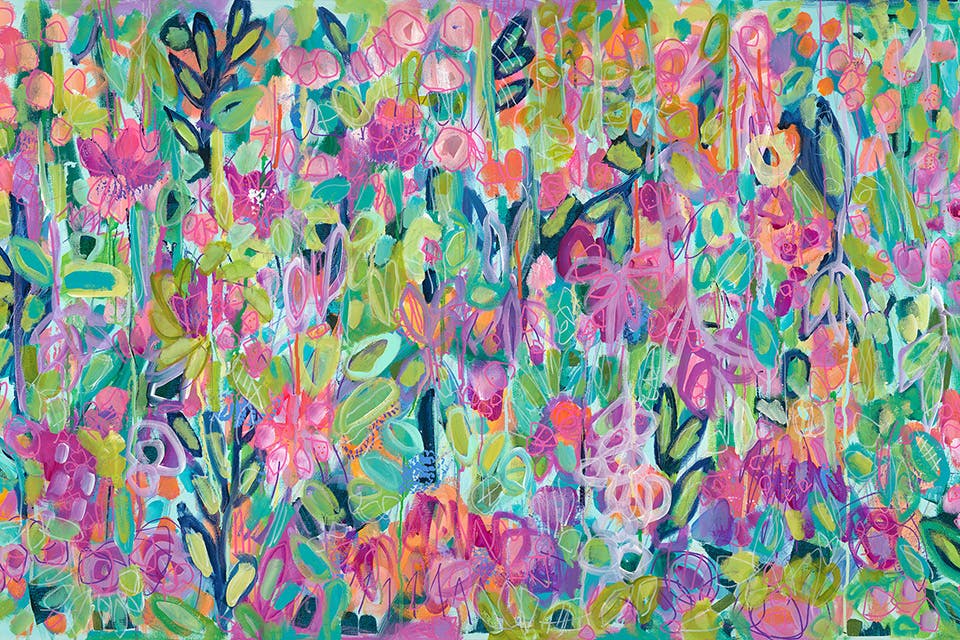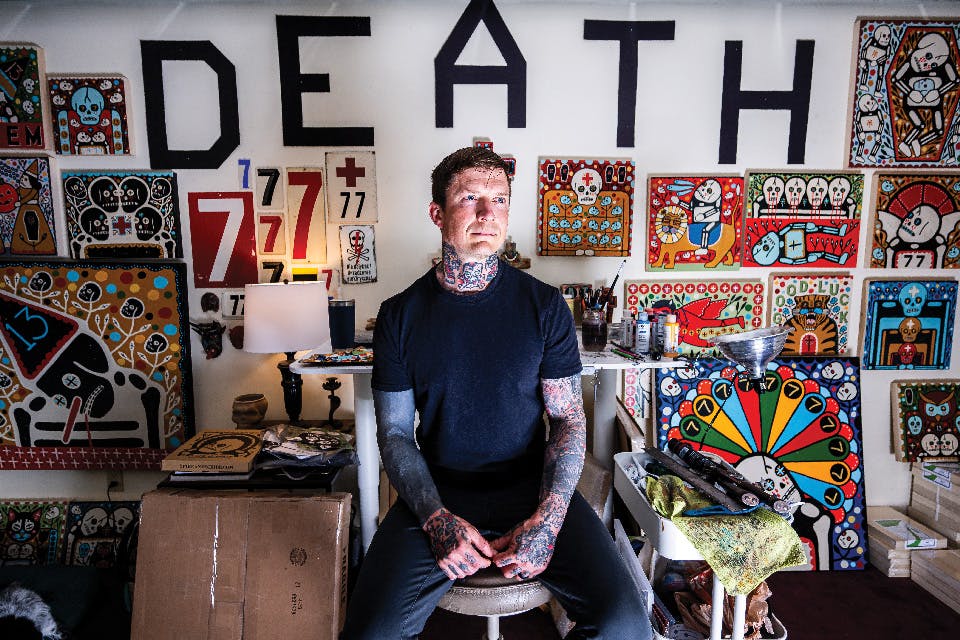Why Artist Mike Egan Makes Vibrant Paintings About Death
The funeral director turned artist has amassed a following in Ohio and beyond. We visited his Youngstown studio to learn why he creates vivid, colorful paintings about death and dying.
Sept./Oct. 2025
BY James Bigley II | Photo by Ken Blaze
Sept./Oct. 2025
BY James Bigley II | Photo by Ken Blaze
In the back of Mike Egan’s studio, a single word hangs over his head in bold, black lettering: DEATH.
The message might seem ominous to anyone unfamiliar with his work, but for the Youngstown-based artist, it’s a constant reminder of what’s at stake.
“It helps me remember that death is going to come one day,” Egan says. “I want to keep doing what I love while I’m living.”
At 48, Egan is obsessed with the macabre. Each canvas that hangs in his studio holds a variety of painted skulls. Some are cracked, white and grinning. Others are brilliant and blue, their hollow eyes filled with the golden No. 7. The number is symbolic, not for its role in divinity, but for the year of his birth, 1977.
“Filling in their eyes makes them look more alive, rather than just leaving a dead, black space,” he says. “I always liked the idea of busyness in my work. I want your eyes to dart all over the piece.”
His paintings capture skeletons, devils, roaring tigers and black cats in a flash-tattoo style. Each creation rages with bold lines, saturated color and a skater-punk aesthetic ripe with religious iconography. It’s this convergence of vibrant life and mesmerizing death that has given him national attention in galleries across Los Angeles, New Orleans, Chicago and New York.
“Dying is a heavy topic,” Egan admits. “I think what I’m trying to do with my art is paint a picture that isn’t so dark and heavy. I feel like my paintings can be much more of a celebration of life instead of cheering on the death of human beings.”
As an example, he points to the custom poster he made in 2022 for a Pearl Jam concert in Louisville, Kentucky. The band’s merch person sought him out after seeing his work on social media. For that piece, Egan created a blue skeleton gripping a pipe between its teeth. A red Sacred Heart of Jesus glowed from its chest. Six other yellow skulls with crosses in their eyes sprouted around it like dead flowers.
“They paid me with 100 posters I could turn around and sell myself,” Egan says. “They sold in about 30 seconds.”

The walls of artist Mike Egan’s Youngstown studio are lined with his colorful paintings. (photo by Ken Blaze)
As a kid born and raised in Pittsburgh, Egan was surrounded by crayons and coloring books. He’d sometimes trace over cartoons in newspapers, comics and magazines. Some of his favorite creations were made by painting shapes on paper and then folding it to create perfect mirror images, an aesthetic that remains in his work today.
After high school, he got his bachelor’s degree in fine arts from Edinboro University with a focus on printmaking. There, he drew inspiration from the raw, human suffering of German expressionists like Kathe Kollwitz and the festive woodcuts of Jose Guadalupe Posada’s decorative calaveras. But Egan lost the tools to continue printmaking when he returned home to Pittsburgh after graduating in 2000. So, he pivoted to painting instead and began searching for full-time work.
His first real job was working as an aircraft detailer at the Pittsburgh International Airport. Two hours into his first day of training on Sept. 11, 2001, the first plane crashed into the World Trade Center. Shortly thereafter, he was let go.
“It felt very scary,” Egan says. “It made me feel like nothing was safe or secure.”
Desperate to find a more permanent position, Egan turned to funeral directing and embalming. He saw this sharp left turn into the deathcare industry as a low-risk investment where he would never be faced with a shortage of work. Plus, he had a penchant for darker source material, and it only required one year of mortuary school.
“I think I always had it in my head that no matter what I did next, I would use it as a stepping stone for my art,” Egan says. “I fully jumped into it not knowing anything about the business.”
Two weeks after starting school, he moved into the third floor of a funeral home with four other students. Together, they learned how to remove bodies from homes, embalm and assist with restorations, and dress the deceased for funerals. The first body he cared for had been autopsied.
“He had the Y-incision on his chest that went down to his belly button,” says Egan, his voice softening. “His guts were in a biohazard bag. His head, chest and belly were all flapped open. They looked at me and asked, ‘Are you OK with this?’ And I said, ‘Yep. I’m good.’”

Mike Egan made a coffin featuring his artwork (above); Ohio-based EarthQuaker Devices hired him to design the artwork (right) for one of its guitar pedals. (photos by Ken Blaze)
After mortuary school and a one-year internship at Fox Funeral Home in Saxonburg, Pennsylvania, Egan snagged a job as an embalmer at Bean Funeral Home in Reading, Pennsylvania, about 260 miles east of his hometown. For two years, he worked every weekend, from 9 a.m. Friday through 5 p.m. Monday. He estimates during that time he laid to rest about 1,000 bodies.
“I grew to hate it because I felt like I was married to that job,” Egan says. “I was on call 24 hours a day, four days a week, and I didn’t really feel like I had a life outside of work.”
Between funerals, he poured himself into his paintings. His earliest works were much more in line with the neo-expressionism of Jean-Michel Basquiat: entangled, crude and twisted with muted colors, bold linework and red curtains of running paint.
One of these early works has a few skulls, their eyes like black pits, floating around a somber man in what looks like a red puffy jacket. Blocked lettering on the print reads: WE BLEED BLACK BLOOD.
“I was very much trying to do that sloppy, almost childlike line work that Basquiat was doing,” Egan says of the painting. “But as I’ve learned as an artist, you can’t really force those things. That was natural for him to do and it worked for him, but I was starting to develop something.”
He continued to pair his profound respect for the dead with his earlier printmaking inspiration to deliver cleaner lines with brighter colors. As he created more and more of his work, he started sharing it online. A friend took notice and asked if he was interested in showing some of his art at a small gallery in Pittsburgh in 2006. Egan sold three of his paintings on opening night.
“All these other people from other cities started seeing the work from social media,” Egan says. “A woman in Portland, Oregon, wanted me to do a show up there; a gallery in Lancaster wanted me to do a show out there. It just kept growing and growing.”
It was enough for Egan to leave the funeral business behind forever and carry it forward in his art.
Back in the studio, Egan stands in front of a desk where he keeps an assortment of crosses, candles and knickknacks engraved with Catholic saints. Beside them, he’s got a bag of 100 paper templates he uses to perfectly recreate the skulls, cats and other creatures in his work.
“I trace these and then sketch everything else out onto canvas or wood panels before I paint them,” he says. “If I don’t like what I paint, I paint over it again. Sometimes, I take sandpaper through it and pull up some of the older designs.”
This technique is most notable on pieces like “We Stayed Together ’Til The End,” which shows five white, grinning skulls stacked one on top of the other. From 6 feet away, they’re all identical. But when you get up close, you suddenly realize one wears a raised tulip on its crown, another wears pennants like a bandana. Each is unique.
“It’s like this ghostly thing that comes up from underneath,” Egan says. “I build up these layers and then use sandpaper to strip those layers back down.”
Like his art, Egan’s got layers to him. He doesn’t share many personal details about his life or the tragedies he’s experienced. When asked if he’s afraid of dying, he pauses for a moment and then lets out a deep sigh as if he’s forced to exorcise the answer.

“His art is focused on death, but there's a positivity to it so that you can use it as motivation to live your live," says filmmaker Doug Helmick who made a documentary about artist Mike Egan. (photo by Ken Blaze)
“Oh, I think I’d be sad, but I don’t know about being afraid,” he says. “I think I’d be angry because I feel like there’s so much I want to do. I just got married in November, so I think not having that time with my wife and having to say goodbye that quickly would be a bit of a bummer.”
But the fear of what comes after death? He doesn’t think about it. He only thinks of the life that he has now and what it means to create art that resonates with people.
“His art is focused on death, but there’s this positivity to it so that you can use it as motivation to live your life,” says filmmaker Doug Helmick.
Helmick’s documentary “Death: The Life of Mike Egan” was nominated for the Atlanta Shortsfest’s 2025 Impact Award. In the film, Egan assembles a coffin created by Eric Rauschenbach, a Struthers, Ohio, native. As Egan tells his own story, he paints each panel of the coffin. A flying skeleton holds two blue skulls, one in each hand, a symbolic marker of his experience during 9/11. Another skeleton wearing a grey wolf mask holds a tiny, black coffin.
“That one’s about having issues with self-esteem and hiding myself,” Egan admits. “Much like the other animals in my work, which always feel alive and more uplifting, masks are a sense of empowerment. You can put on a mask and feel like a completely different person.”
A skeleton wearing the face of an animal is perhaps the latest evolution of Egan’s work, a slight turn away from death and toward the living.
“I’ve noticed this transition in his art over the time I’ve been with him,” says his wife, Alison Gasser. “There are a lot more colors, more characters.”
Egan estimates he’s created 2,000 paintings so far and there’s no sign of him slowing down. He has plans to dismantle his coffin and sell each of the panels as collector’s items. This fall, he hopes to create miniature box sets that contain one print for each of those panels. And he plans on continuing his annual tradition of painting “tiny deaths,” a series of 8-by-8 canvases that call attention to milestone moments in someone’s life.
“Tiny deaths are those moments in our lives that change us in some way before we experience the big death,” Egan says. “This year, I plan on making 100 of them and then I’ll pay it forward by donating a portion of that money to charity.”
In Egan’s eyes, his tiny deaths series isn’t designed to reanimate the past. Instead, they’re meant to help someone move on so that they can live a more fruitful life.
“I hope,” he says, “that people can see these paintings and find some sense of closure.”
For more Ohio inspiration, sign up for our Ohio Magazine newsletters.
Ohio Magazine is available in a beautifully designed print issue that is published 7 times a year, along with Spring-Summer and Fall-Winter editions of LongWeekends magazine. Subscribe to Ohio Magazine and stay connected to beauty, adventure and fun across our state.
Related Articles

Restoration Begins on George Sugarman’s ‘Cincinnati Story’ at Pyramid Hill Sculpture Park
The colorful, iconic sculpture is undergoing restoration ahead of a 2026 public rededication. READ MORE >>

The Butler Institute of American Art Adds Mateo Blanco Paintings to Collection
The acclaimed artist donates his signature pieces “Presidential Flag” and “Yellow Flag” to The Butler Institute of American Art in Youngstown, expanding the museum’s reflections on American identity. READ MORE >>

Flowers Power Alisa H. Workman’s Beautiful Paintings
The southwest Ohio-based artist embraces spontaneity in creating her floral-inspired canvases. READ MORE >>



